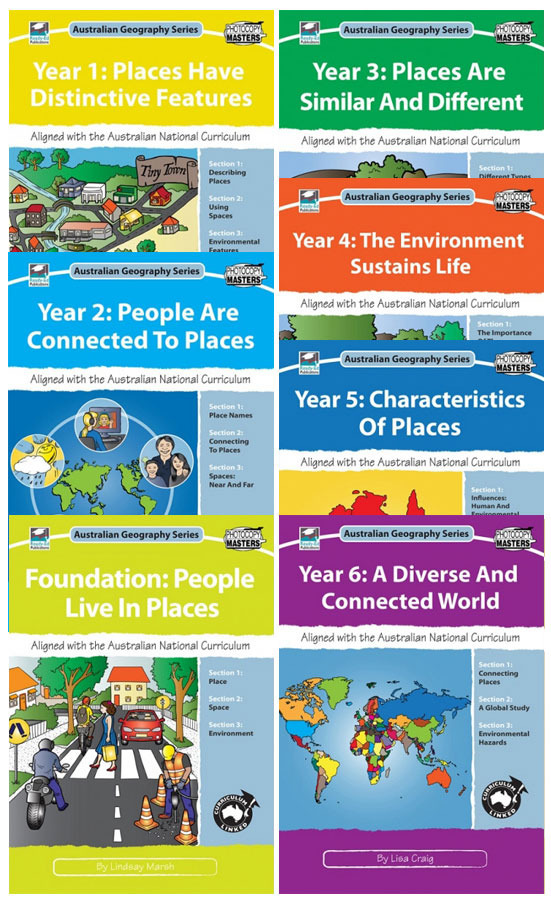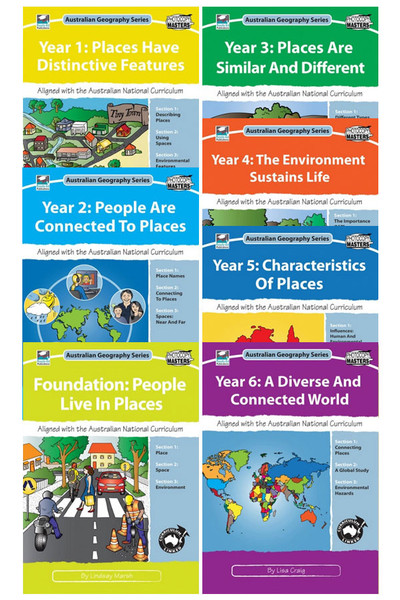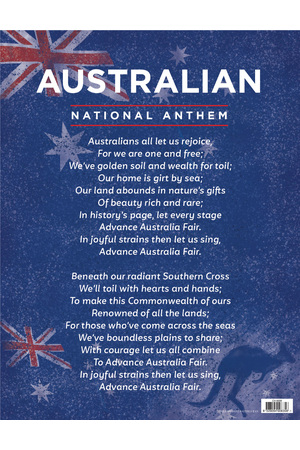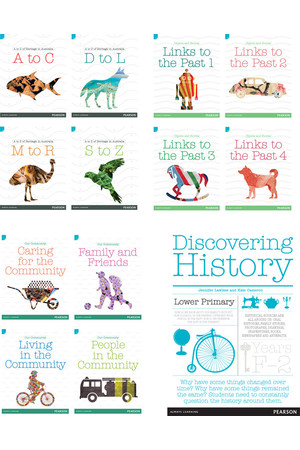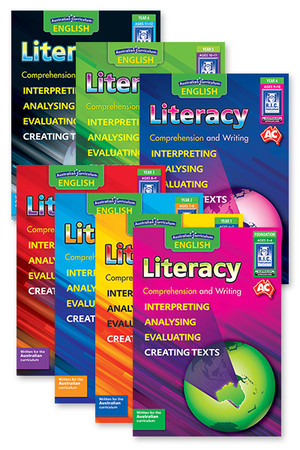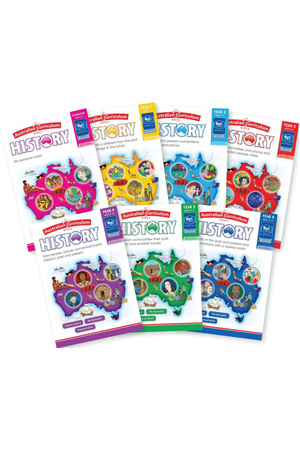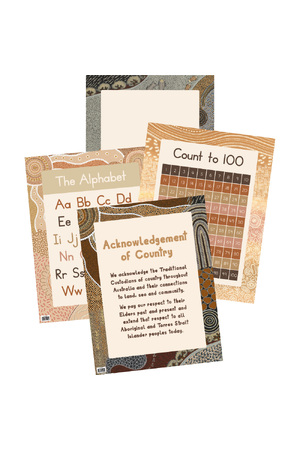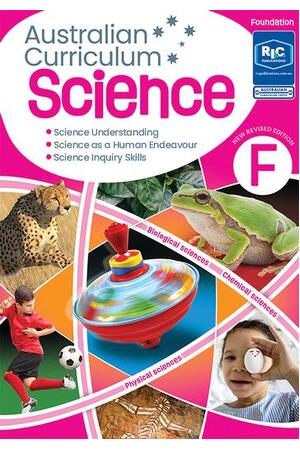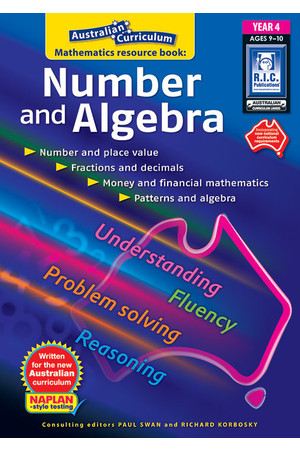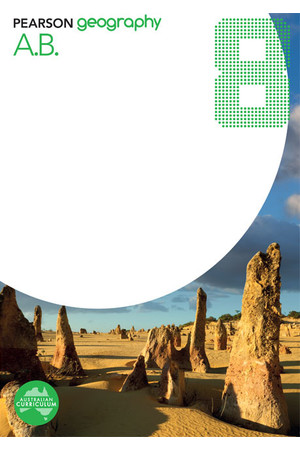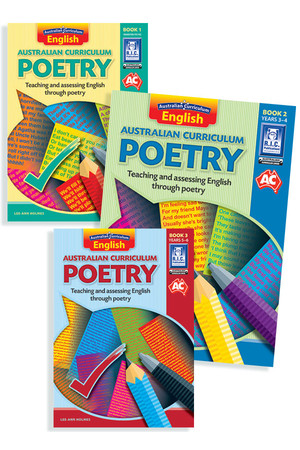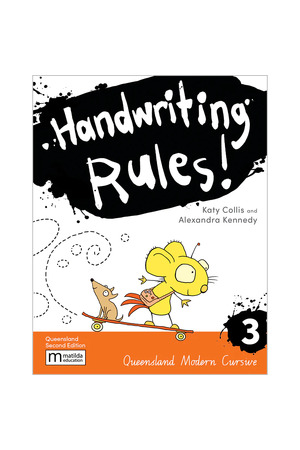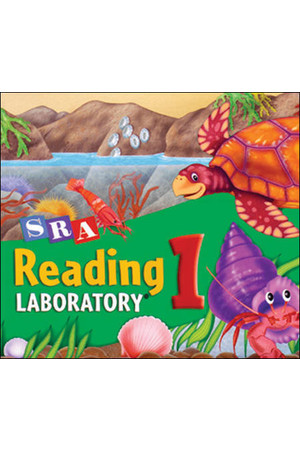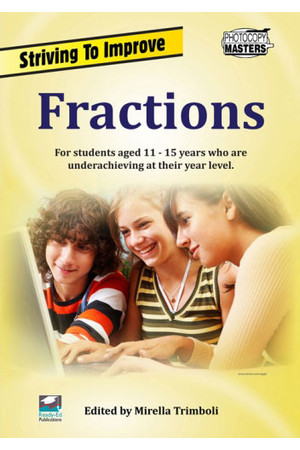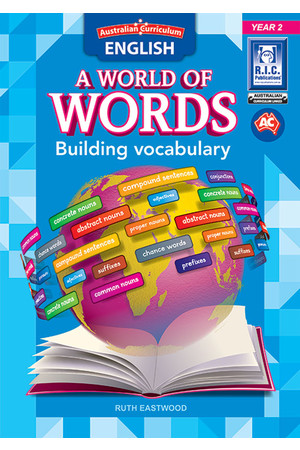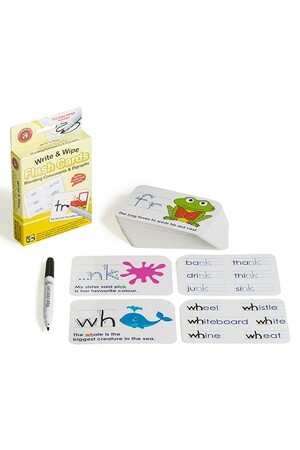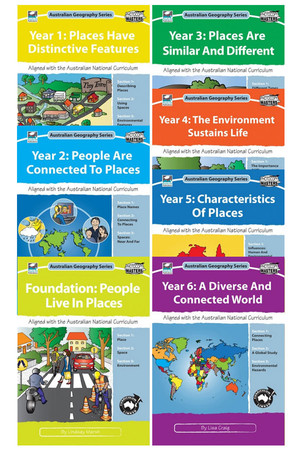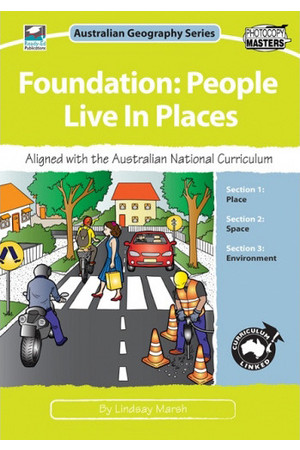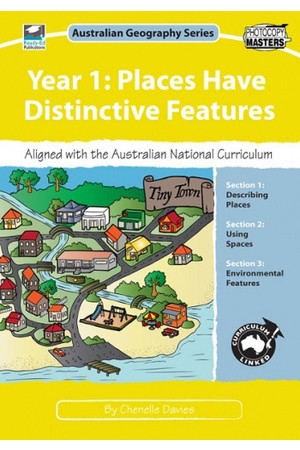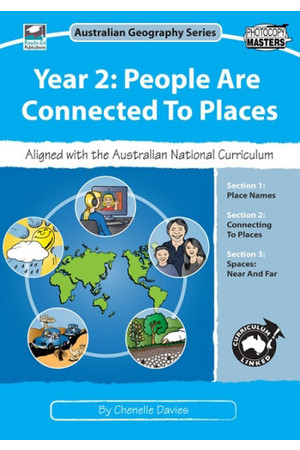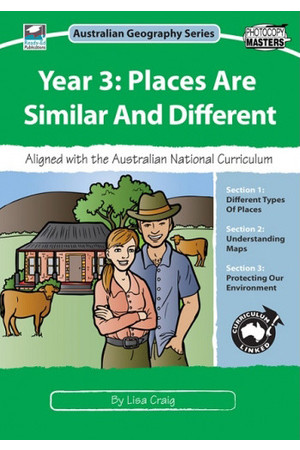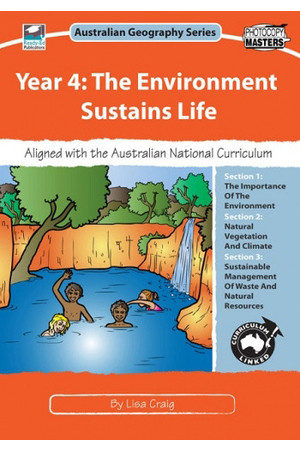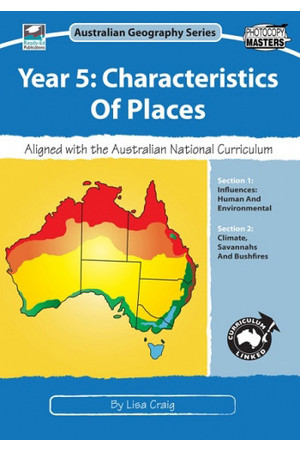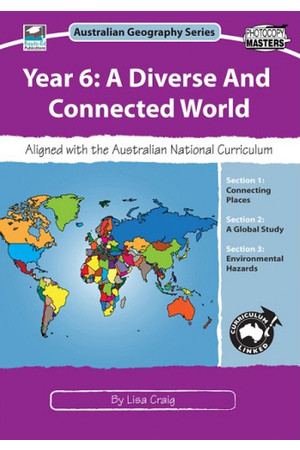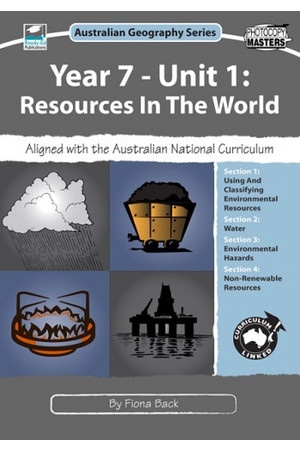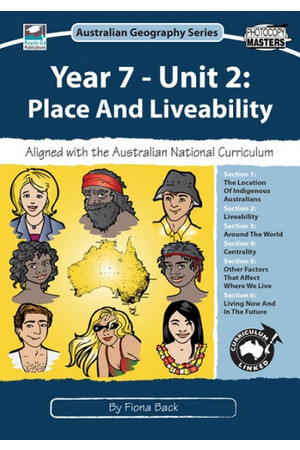Part of the series Australian Geography Series.
View all products in this series
Australian Geography Series is a nine book series linked to the Australian National Curriculum. All of the activity pages in these book are visually appealing to help students process the concepts being taught. As students complete the activities they will also be learning and practising a range of geographical skills, such as: sorting and classifying, mapping, labeling, matching, graphing and conducting simple surveys to collect data.
Australian Geography Series Pack
This pack includes seven books of this series (Foundation to Year 6) at a discounted price.
Foundation: People Live in Places
Foundation: People Live In Places has been written specifically for students in their first few years of schooling who are living in Australia and studying Geography. The book is linked to the Australian National Curriculum. The activities in this book have been designed to help students describe and appreciate the places around them and the areas in which they live. Students are encouraged to recognise the term ‘features of a place’, and are asked to differentiate between natural and built features in familiar places. They are also asked to categorise places that are familiar to them. In addition, the children are given the opportunity to recognise that we share places with others and therefore have a shared responsibility to look after the places that we use and keep them safe places to visit. Exploring how places provide people with basic needs and examining places that are special to Indigenous Australians also feature. Students will develop an understanding of how places and their features are represented on maps. They are asked to create their own maps and rearrange the features on maps to show how spaces can be used in different ways. They are also asked to draw possible routes on maps, and recognise that features on maps can be shown from above, as well as from the side. This book is a wonderful resource for those who teach at Foundation level. The illustrations, together with the accessible layout, means that the activity pages are enjoyable and engaging for young children. This makes the introduction of geographic skills and knowledge manageable.
Year 1: Places Have Distinctive Features
Year 1: Places Have Distinctive Features has been written for students living in Australia who are studying Geography in Year 1. It is divided into three clear sections which connect to the National Curriculum. The first section, entitled Describing Places, includes activities that allow students to identify and describe natural, managed and constructed features of places, locate them on maps, say how they should be cared for, and recognise how they can change. The activities in this section also provides students with the opportunity to examine Dreaming stories which identify the natural features of a place. The second section of this book, Using Spaces, gives students the opportunity to investigate the different ways in which spaces are used in their home, school and community. It explores the idea that environmental characteristics and time of day affect how a space is used, and creates an awareness that rearranging spaces can suit different purposes and needs. Environmental Features, the third and final section of the book, helps the children to describe, measure and record the weather, as well as compare the weather in their area to the weather in other places in Australia. The study of an indigenous seasonal calendar is also included.
Year 2: People are Connected to Places
Year 2: People are Connected to Places is written for students living in Australia who are studying Geography in Year 2. It is divided into three clear sections which align to the Australian National Curriculum. The first section, Place Names, will help students begin to understand that the names of places and features of places have meanings. Students will be given the opportunity to examine the significance of indigenous names and begin to understand that different places are different sizes and can thus be described in terms of scale. Students will also be asked to label major geographical divisions on a globe. The second section Connecting To Places, explores students’ connections with places both close and distant. Students will learn that connections can be formed not only with places where they have been, but also with places that they have heard of: on TV, in books or through other people. Places frequently visited in the local community, places of birth and places in other countries all feature in this section. The activities in this section also help students to understand the special relationship that Indigenous Australians have with the land, sea and animals of their place. The final section in this book entitled Spaces: Near And Far, considers the concept that distance influences the places where we go and how often we visit those places. The activities presented in this section encourage students to see the connection between these two variables and discuss the reasons why people visit distant places less frequently than places which are nearby.
Year 3: Places are Similar and Different
Year 3: Places Are Similar And Different has been written specifically for students in Year 3, who are living in Australia and studying Geography. The activity book has been divided into three sections: Different Types Of Places, Understanding Maps and Protecting Our Environment. Each section is closely linked to the Australian National Curriculum. In Section 1, Different Types Of Places, students are encouraged to think about what it would be like to live in a different type of place to the place in which they currently reside. Among other activities, students will be asked to consider the human and natural characteristics of different types of places, compare and contrast rice growing in Australia and Indonesia, tea growing in Sri Lanka and Australia and investigate similarities and differences between Australia and Papua New Guinea. In Section 2, Understanding Maps, activities and tasks are designed to build mapping skills in a variety of map types including: weather, political, natural resources and floor plans. Students will be asked to locate places on a local, national and global scale using compass directions, grid references and scale. Special attention is given to locating places and features within Australia and locating countries on a map considered to be Australia's neighbours. In Section 3, Protecting Our Environment, students will think about the importance of caring for and protecting special places within Australia. They will consider the consequences of not caring for a place and devise strategies to improve places for all. Year 3: Places Are Similar And Different is a student-friendly resource for 8-9 year olds studying Geography. The book’s illustrations and graphic data give students ample support to think about the big issues in Geography that will affect how people live today and in the future.
Year 4: The Environment Sustains Life
Year 4: The Environment Sustains Life has been written specifically for students in Year 4, who are living in Australia and studying Geography. The activity book is divided into three sections: The Importance Of The Environment; Natural Vegetation And Climate; and Sustainable Management Of Waste And Natural Resources. Each section is closely linked to the Australian National Curriculum. The first section, The Importance Of The Environment, examines the relationship that Indigenous Australians have formed with the environment over time and the circumstances under which these relationships were formed. Students will also explore the distribution of Indigenous Australians before colonisation and how their ways of living were adapted to the resources of their Country and Place. Also included are activities which encourage students to recognise that places, for a variety of reasons, are significant to people and animals and should be preserved for future generations to enjoy. The second section, Natural Vegetation And Climate, focuses on savannahs as a type of natural vegetation in Australia and South America and explores how climate affects this vegetation. The natural processes that shape the Earth’s surface, in particular landforms also feature in this section together with and exploration of how the daily weather is determined by air pressure systems and fronts. Students will extend their understanding of place by developing mapping skills. The third section, Sustainable Management Of Waste And Natural Resources, investigates the management of waste through the exploration of reducing, reusing, recycling and replacing. Students will investigate glass and understand that it is made from raw materials produced by the environment. Year 4: The Environment Sustains Life is a teacher-friendly resource for 9 to10 year olds studying Geography. The topics developed for each section are well-supported by illustrations, graphic and photographic resources, which will help stimulate students’ thinking about the way we live locally, nationally and globally. The strong research component built into tasks will invite students to dig deeper into geographical questions from their own and other people’s points of view.
Year 5: Characteristics of Places
Year 5: Characteristics Of Places has been written specifically for students in Year 5 who are living in Australia and studying Geography. The activity book is arranged into two sections: Influences: Human And Environmental and Climate, Savannahs And Bushfires. Both sections are closely linked to the Australian National Curriculum. The first section, Influences: Human And Environmental, explores how landforms affect the development of settlements, and how people affect the environmental characteristics of a place through changes such as urban planning. Students are given the opportunity to investigate local planning issues and in this way begin to recognise that people influence the human characteristics of places and the management of spaces within them. The second section, Climate, Savannahs And Bushfires, introduces students to concepts related to climate such as: temperature and rainfall patterns, elevation and vegetation. Students are asked to make a link between climate and where people live. The climate zone and sustainable land use of Australia’s hot and humid savannahs is compared and contrasted with those in East Indonesia. Students will be asked to explain the threats to the savannah lands and research possible responses to these threats. This section also explores indigenous land and resource management and evaluates the changes that have occurred to the land after colonisation. The effects of bushfires on communities and environments also features. Year 5: Characteristics Of Places is a teacher-friendly resource for 10-11 year olds studying Geography. The influence of climate on human activities will be explored from multiple perspectives through tasks designed to develop thinking skills. Information is supported by ample illustrations, photograph studies and map data.
Year 6: A Diverse and Connected World
Year 6: A Diverse And Connected World has been written specifically for students in Year 6, who are living in Australia and studying Geography. The activity book is arranged into three sections: Connecting Places, A Global Study and Environmental Hazards. Each section is closely linked to the Australian National Curriculum. The first section, Connecting Places, is designed to raise students’ awareness that places are linked to one another. It explores Australia's connection to the Asia region through trade, tourism, aid and historic ties. Students are also asked in this section to use geographic tools to locate different parts of Asia on the map. The second section, A Global Study, examines different regions in the world and their populations. Students will be asked to explore concepts such as: why citizens in some countries have higher living standards than others and how the natural resources in a place generate industries and employment. Students will reflect on the causes of poverty in the world and research programmes in Australia and other parts of the world that aim to bridge the gap between developed and developing countries. This section also considers the similarities and differences in religions between Australia and selected countries of the Asia region. The third section, Environmental Hazards, focuses on natural disasters that affect people and places and our responses to these hazards. Tasks will require students to assess the risks of various environmental hazards and evaluate action plans for survival. A major component of this section is a case study on the Black Saturday bushfires in Victoria. This environmental disaster will be considered from multiple perspectives by students, who will then synthesise their research findings to suggest prevention and management strategies. Year 6: A Diverse And Connected World is a teacher-friendly resource for 11-12 year olds studying Geography. An inquiry-based approach is applied in the activities and research tasks. Students are challenged to weigh up the visual and graphic data presented, to form their own understandings about how people and places are connected to one another and the world.
| SKU | REP-1600-1606-Pack |
| Publisher | Ready-Ed Publications |
| Product Type | Teacher Resources, Bundles & Packs, |
| Year Level | Foundation, Year 1, Year 2, Year 3, Year 4, Year 5, Year 6, |
| Author(s) | Lindsay Marsh |
Be The First To Review This Product!
Help other Teacher Superstore users shop smarter by writing reviews for products you have purchased.


